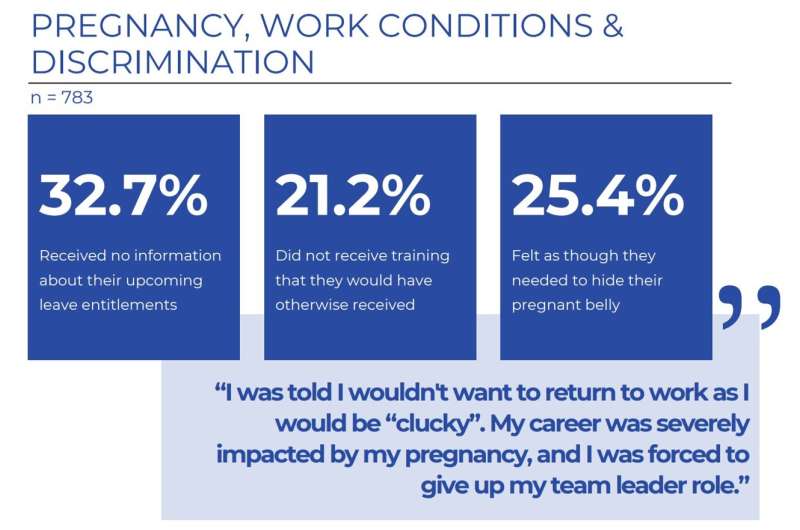Examining why women are no further ahead in the workforce than 30 years ago
A report exploring the working conditions of pregnant employees and parents has been released today, calling for major changes in Australian workplaces to counter the “vast discrimination and disadvantage” experienced by these groups.
It is the first national review of this group of workers in a decade, undertaken by researchers from the University of South Australia.
The key recommendations of the National Review into Pregnant and Parent Workers Work Conditions and Discrimination include:
- Closer consultation between employers and employees to ensure the former understand pregnancy-related needs and communicate role changes for new parents returning to work
- Appropriate space for breastfeeding or expressing milk (locked door, comfortable chair, storage facilities)
- Management and HR should foster an inclusive workplace culture that does not tolerate disrespectful or negative behavior
- Create greater gender equality through providing partner parental leave and/or flexible work arrangements
- Training and career progression should be available to all, regardless of the work arrangements
- Ergonomic adjustments need to be made in the workplace to minimize risk of harm
- There must be greater mandatory regulation of employers to ensure they are meeting their legal requirements.
The report’s lead author is Dr. Rachael Potter from the Centre for Workplace Excellence at the University of South Australia (UniSA). It is the outcome of a 2023 study which found that 30 years after it was outlawed in Australia, workplace discrimination is still rife for pregnant women and parents.
Key findings from the 2023 study were:
- More than 60% of new mothers returning to work say their opinions are often ignored, they feel excluded, and are given unmanageable workloads
- 25% of women said their workplace did not provide appropriate breastfeeding facilities
- Almost one in five women returning from maternity leave were refused requests to work flexible hours or from home
- 30% of pregnant women received no information about their upcoming leave entitlements, which is a legal requirement in workplaces
- 23% of women said they felt they needed to hide their pregnant belly at work.
- While on leave, 22% had their tasks or job altered against their wishes, and 73% would have liked to take more maternity leave to care for their child.
- 38% reported negative or offensive remarks for taking time off work to care for a sick child.
- 13% were treated so badly they had no option but to resign
More information:
Report: www.unisa.edu.au/contentassets … workers-18032024.pdf
Citation:
Examining why women are no further ahead in the workforce than 30 years ago (2024, March 20)
retrieved 20 March 2024
from https://phys.org/news/2024-03-women-workforce-years.html
This document is subject to copyright. Apart from any fair dealing for the purpose of private study or research, no
part may be reproduced without the written permission. The content is provided for information purposes only.

A report exploring the working conditions of pregnant employees and parents has been released today, calling for major changes in Australian workplaces to counter the “vast discrimination and disadvantage” experienced by these groups.
It is the first national review of this group of workers in a decade, undertaken by researchers from the University of South Australia.
The key recommendations of the National Review into Pregnant and Parent Workers Work Conditions and Discrimination include:
- Closer consultation between employers and employees to ensure the former understand pregnancy-related needs and communicate role changes for new parents returning to work
- Appropriate space for breastfeeding or expressing milk (locked door, comfortable chair, storage facilities)
- Management and HR should foster an inclusive workplace culture that does not tolerate disrespectful or negative behavior
- Create greater gender equality through providing partner parental leave and/or flexible work arrangements
- Training and career progression should be available to all, regardless of the work arrangements
- Ergonomic adjustments need to be made in the workplace to minimize risk of harm
- There must be greater mandatory regulation of employers to ensure they are meeting their legal requirements.
The report’s lead author is Dr. Rachael Potter from the Centre for Workplace Excellence at the University of South Australia (UniSA). It is the outcome of a 2023 study which found that 30 years after it was outlawed in Australia, workplace discrimination is still rife for pregnant women and parents.
Key findings from the 2023 study were:
- More than 60% of new mothers returning to work say their opinions are often ignored, they feel excluded, and are given unmanageable workloads
- 25% of women said their workplace did not provide appropriate breastfeeding facilities
- Almost one in five women returning from maternity leave were refused requests to work flexible hours or from home
- 30% of pregnant women received no information about their upcoming leave entitlements, which is a legal requirement in workplaces
- 23% of women said they felt they needed to hide their pregnant belly at work.
- While on leave, 22% had their tasks or job altered against their wishes, and 73% would have liked to take more maternity leave to care for their child.
- 38% reported negative or offensive remarks for taking time off work to care for a sick child.
- 13% were treated so badly they had no option but to resign
More information:
Report: www.unisa.edu.au/contentassets … workers-18032024.pdf
Citation:
Examining why women are no further ahead in the workforce than 30 years ago (2024, March 20)
retrieved 20 March 2024
from https://phys.org/news/2024-03-women-workforce-years.html
This document is subject to copyright. Apart from any fair dealing for the purpose of private study or research, no
part may be reproduced without the written permission. The content is provided for information purposes only.
